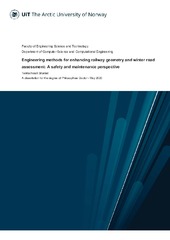Numerical Simulations of Turbulence at the Boundary of Fusion Plasma
Permanent link
https://hdl.handle.net/10037/25462Date
2022-05-15Type
MastergradsoppgaveMaster thesis
Author
Jäntti, HenrikAbstract
Numerical simulations of reduced fluid models describing magnetized plasmas have previously been used to study the boundary of fusion plasmas extensively. A common approximation applied to these models is the so-called Boussinesq approximation. One of the requirements for the Boussinesq approximation to be applicable is that the background particle density is significantly higher than the fluctuations in the particle density. Experimental measurements have revealed that at least in the scrape-off layer (SOL) this is not the case, we will therefore investigate the effects of the Boussinesq approximation in this thesis. In addition to this, we also investigate the effects of linearizing the logarithmic density in the drift wave term of the models. To do this we derive four sets of reduced fluid equations describing the edge and SOL regions of a tokamak plasma, one for each combination of approximations. These models are then simulated numerically using the BOUT++ framework. Single point time-series measurements from the simulations are then analysed using the stochastic filtered Poisson process in addition to conventional statistical methods. From the analysis, we observe that there are noticeable differences between the different models, where the largest difference appears when the Boussinesq approximation is used. We found that the logarithmic particle density in the drift wave term generated increased shear flow in the edge region increasing the confinement of plasma to the edge region reducing the overall particle density in the SOL. By relaxing the Boussinesq approximation we observed that structures moving radially outward through the domain have smaller sizes and that the structures in the Boussinesq approximated case, and that these structures decrease in size at faster rates. This indicates that the use of the Boussinesq approximation influences the results of numerical simulation, and deeper studies into the differences between the two cases need to be done.
Publisher
UiT Norges arktiske universitetUiT The Arctic University of Norway
Metadata
Show full item recordCollections
- Mastergradsoppgaver IFT [102]
Copyright 2022 The Author(s)
The following license file are associated with this item:
Except where otherwise noted, this item's license is described as Attribution-NonCommercial-ShareAlike 4.0 International (CC BY-NC-SA 4.0)
Related items
Showing items related by title, author, creator and subject.
-
Engineering methods for enhancing railway geometry and winter road assessment: A safety and maintenance perspective
Brustad, Tanita Fossli (Doctoral thesis; Doktorgradsavhandling, 2020-06-22)In many areas around the world there are limited transportation possibilities when travelling between key cities. If these areas also experience demanding weather conditions or geography, getting from A to B, during difficult conditions, is usually not optimal in regards to accessibility, safety, and comfort. Under challenging conditions, two essential elements in strengthening accessibility, safety, ... -
Geometric Modeling- and Sensor Technology Applications for Engineering Problems
Pedersen, Aleksander (Doctoral thesis; Doktorgradsavhandling, 2020-10-20)In applications for technical problems, Geometric modeling and sensor technology are key in both scientific and industrial development. Simulations and visualization techniques are the next step after defining geometry models and data types. This thesis attempts to combine different aspects of geometric modeling and sensor technology as well as to facilitate simulation and visualization. It includes ... -
Iceberg Drift-Trajectory Modelling and Probability Distributions of the Predictions
Baadshaug, Ole (Master thesis; Mastergradsoppgave, 2018-06-29)Moving icebergs represent a major problem for shipping, as well as for oil and gas installations in ice infested waters. To be able to take actions against hazardous icebergs, it is necessary to develop models for prediction of iceberg drift trajectories. Many models have been developed in order to do so, using different approaches. These approaches can be divided into two main categories, dynamic ...


 English
English norsk
norsk



